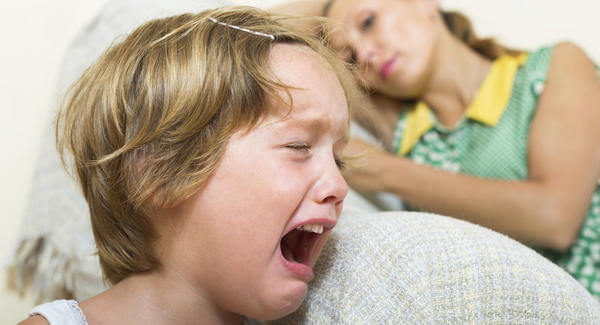Staying Positive When Your Child Tests Your Limits


Reviewed and approved by the psychologist María Alejandra Castro Arbeláez
Does your child test your limits every day? Does he not understand the concept of boundaries or standards? Do not despair, because there is a simple key to successfully staying positive without losing your cool or patience.
“I don’t want a bath,” “I won’t sleep alone,” “I don’t want to” and other children’s tests are not impossible to handle. It’s a myth to think there are ungovernable kids. Pay attention, because in this You Are Mom article, we will show you how to act in a positive way to resolve family conflicts.
Because ultimately, it is absolutely normal for children to challenge and test limits. It lets them experience how far they can go. That is why it is so important not only to establish limits, but to delineate them in the best possible way.
Let’s move from thinking positively to acting positively.
-Anonymous-
Why act positively?
Forget about being absolutely strict. It is not about establishing the indisputable supremacy of punishment, whether physical or emotional. This creates injury in everyone’s lives.

Take your time, with patience, tranquility, peace and, above all, a lot of love. Only in this way can you finally understand what is really happening. What is behind these hostile childish behaviors?
Certainly, the reasons why your child challenges you are small pieces of a puzzle. The solution involves nothing less than acting positively. This is something that, with the day to day life of any adult, can be extremely complicated.
You will see that among the most common reasons for the attitude your child gives you is a need for attention. If that’s not the problem, realize that your child is simply testing the barriers or feeling frustrated by something that happened at school or even with you.
5 Tips for Setting Limits and Staying Positive
Setting limits without being too harsh is possible, as is being flexible. Of course, this does not mean permitting your child to do everything, but rather to educate him about why certain things are prohibited.
Teach your child rather than ordering him around all the time. Use these tips to handle complex situations:
When we are angry, our first reaction is often wrong.
-Rick Warren-

- Always build positivity. Praising achievements and triumphs is usually a very powerful and valuable way to educate. Do not live thinking that everything the child does is wrong. You must also recognize and enhance their positive actions and good behavior. This stimulates and encourages the child to maintain those types of desired behaviors and actions.
- Create a “positive opposite.” It’s possible to avoid saying the word “NO,” and the effects are fabulous. It is not about accepting the unacceptable, but about finding a way to say no in a positive way. That is, find a way to say “no” with a “yes.” For example, don’t say “do not leave your clothes lying on the floor,” and instead say “take the clothes to the dirty laundry hamper.”
- Always be clear about the house rules and values. Be clear even when setting limits. No matter their age, every child needs to know the rules of the home with certainty. These rules establish the schedule of meals, playtime and sleep, give the child household chores and create accepted behaviors and conduct.
- Embrace the power of action, not reaction. Do not get upset with your child’s behavior. Show him that you do not approve at all of that attitude. Stay calm and think about the best way to convey to your child what he must learn in order to correct his actions. Do not get caught in a fight for no reason, because you give him a chance to keep challenging you. Say, “we already talked about the consequences of your actions. I will not discuss this.”
- Say no to second chances, yes to alternatives. From a very young age, it is good to offer alternatives to the child in order to avoid giving second chances. Being consistent and firm in a decision is vital in order to reinforce good habits. Each action has consequences, which always apply! By granting a new opportunity, you teach your child that your word has no weight. You are not serious and he can get away with it because there are no strict rules.
All cited sources were thoroughly reviewed by our team to ensure their quality, reliability, currency, and validity. The bibliography of this article was considered reliable and of academic or scientific accuracy.
- Angulo Rincón, R., i Ballabriga, J., del Claustre, M., Bonillo Martín, A., Viñas i Poch, F., Corcoll Champredonde, A., … & Carbonés, J. (2010). Evaluación de la sintomatología negativista desafiante en niños de 6 a 8 años: concordancia entre padres y maestros. © Psicothema, 2011, vol. 22, núm. 3, p. 455-459. http://aprendeenlinea.udea.edu.co/revistas/index.php/iatreia/article/view/4435
- Barkley, R., & Robin, A. (2011). Adolescentes desafiantes y rebeldes. Madrid: Paidós.
- Céspedes, A. (2007). Niños con pataleta, adolescentes desafiantes. Como manejar los trastornos de conducta en los hijos. Ed Vergara, Chile. http://www.colegioshaddai.cl/wp/wp-content/uploads/2015/08/Niños-con-pataletas.-Adolescentes-desafiantes-Amanda-Cespedes.pdf
- Vásquez, J., Feria, M., Palacios, L., & De la Peña, F. (2010). Guía clínica para el trastorno negativista desafiante. México: Instituto Nacional de Psiquiatría Ramón de la Fente Muñiz.(Serie: Guías clínicas para la atención en trastornos mentales). http://www.inprf-cd.gob.mx/guiasclinicas/trastorno_negativista.pdf
This text is provided for informational purposes only and does not replace consultation with a professional. If in doubt, consult your specialist.
